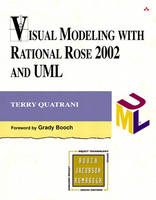
Visual Modeling with Rational Rose 2002 and UML
Addison Wesley (Verlag)
978-0-201-72932-0 (ISBN)
- Titel ist leider vergriffen;
keine Neuauflage - Artikel merken
The third edition of this popular book retains the practical approach to teaching visual modeling techniques and the industry standard Unified Modeling Language. Author Terry Quatrani, the Rose Evangelist from Rational Software Corporation, still uses the simplified case study (a course registration system for a fictional university) that has taught thousands of readers how to analyze and design an application using UML, and how to implement the application using Rational Rose. The screen shots and Rational Rose instructions have been updated to reflect the release of Rational Rose 2002. After a short history of the evolution of UML and a guide to the basic terms of software engineering, the book introduces the concept of requirements, use cases, and class diagrams. Further chapters move toward defining an architecture and even refining the design within the incremental methodology of Rational Rose.
Terry Quatrani, IBM Rational’s UML Evangelist, is responsible for training and transitioning Fortune 500 companies to object technology and for preaching the visual modeling gospel of Grady Booch, Jim Rumbaugh, and Ivar Jacobson. She has spent twenty-one years developing and deploying large software systems. Formerly at GE, she was founding consultant for the Lockheed Martin Advanced Concepts Center.
(NOTE: Each chapter concludes with a Summary.)
Foreword.
Preface.
1. Introduction.
What Is Visual Modeling?
The Triangle for Success.
The Role of Notation.
History of the UML.
The Role of Process.
What Is Iterative and Incremental Development?
The Rational Unified Process.
The Rational Rose Tool.
2. Beginning a Project.
Defining the Right Project.
Eastern State University (ESU) Background.
Risks for the Course Registration Problem.
ESU Course Registration Problem Statement.
3. Creating Use Cases.
System Behavior.
Actors.
Use Cases.
Use Case Relationships.
Use Case Diagrams.
Activity Diagrams.
4. Finding Classes.
What Is an Object?
State, Behavior, and Identity.
What Is a Class?
Stereotypes and Classes.
Discovering Classes.
Documenting Classes.
Packages.
Objects and Classes in the ESU Course Registration Problem.
Class Diagrams.
5. Discovering Object Interaction.
Use Case Realization.
Documenting Scenarios.
Sequence Diagrams.
Sequence Diagrams and Boundary Classes.
Complexity and Sequence Diagrams.
Collaboration Diagrams.
Why Are There Two Different Diagrams?
Sequence Diagram for the ESU Course Registration System.
6. Specifying Relationships.
The Need for Relationships.
Association Relationships.
Aggregation Relationships.
Association or Aggregation?
Naming Relationships.
Role Names.
Multiplicity Indicators.
Reflexive Relationships.
Finding Relationships.
Package Relationships.
7. Adding Behavior and Structure.
Representing Behavior and Structure.
Creating Operations.
Documenting Operations.
Relationships and Operation Signatures.
Creating Attributes.
Documenting Attributes.
Displaying Attributes and Operations.
Association Classes.
8. Discovering Inheritance.
Inheritance.
Generalization.
Specialization.
Inheritance Trees.
Single Inheritance versus Multiple Inheritance.
Inheritance versus Aggregation.
9. Analyzing Object Behavior.
Modeling Dynamic Behavior.
States.
State Transitions.
Special States.
State Transition Details.
State Details.
10. Checking the Model.
Why Homogenize?
Combining Classes.
Splitting Classes.
Eliminating Classes.
Consistency Checking.
Scenario Walk-Through.
Event Tracing.
Documentation Review.
11. Designing the System Architecture.
The Need for Architecture.
The Architecture Team.
The 4+1 View of Architecture.
The Logical View.
The Implementation View.
The Process View.
The Deployment View.
The Use Case View.
12. Building the Iterations.
The Iteration Planning Process.
Designing the User Interface.
Adding Design Classes.
The Emergence of Patterns.
Designing Relationships.
Designing Attributes and Operations.
Designing for Inheritance.
Coding, Testing, and Documenting the Iteration.
Using Reverse Engineering to Set the Stage for the Next Iteration.
Appendix A: Code Generation and Reverse Engineering with C++.
Appendix B: Code Generation and Reverse Engineering with Visual C++ and Visual Basic.
Appendix C: A Visual Basic Example.
Glossary.
Index. 0201729326T09262002
| Erscheint lt. Verlag | 5.11.2002 |
|---|---|
| Reihe/Serie | The Addison-Wesley Object Technology Series |
| Verlagsort | Boston |
| Sprache | englisch |
| Maße | 178 x 229 mm |
| Gewicht | 540 g |
| Themenwelt | Informatik ► Grafik / Design ► Digitale Bildverarbeitung |
| Mathematik / Informatik ► Informatik ► Programmiersprachen / -werkzeuge | |
| Informatik ► Software Entwicklung ► Objektorientierung | |
| ISBN-10 | 0-201-72932-6 / 0201729326 |
| ISBN-13 | 978-0-201-72932-0 / 9780201729320 |
| Zustand | Neuware |
| Haben Sie eine Frage zum Produkt? |
aus dem Bereich


